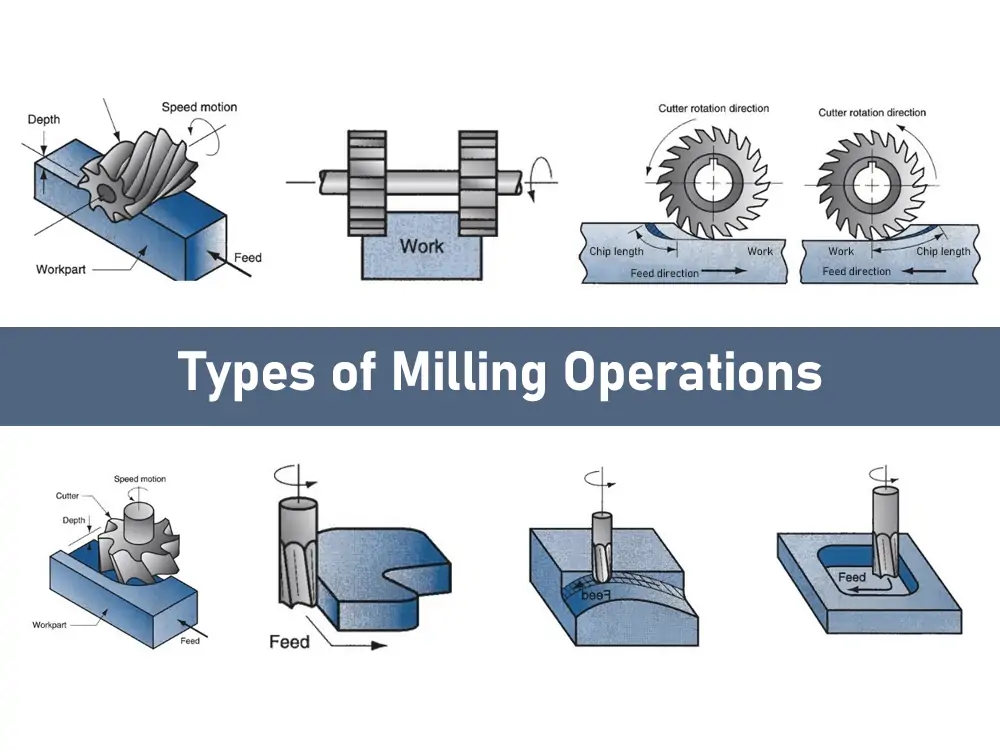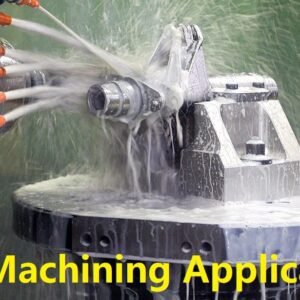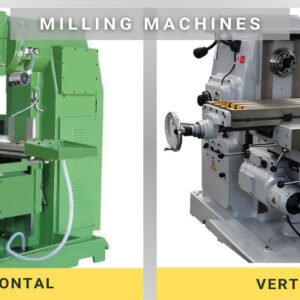今日の業界で, CNCフライス加工 is used for everything from aerospace turbine blades and medical implants to automotive transmission housings and consumer electronics. What makes it so versatile is that there isn’t just one milling method—there are multiple milling operations, each suited for specific shapes, 表面, そして仕上げ. By choosing the right one, manufacturers ensure efficiency, 正確さ, と品質.
Before we dive into the different operations, it’s essential to understand how CNC milling actually works and what components make it possible.
CNC フライス加工のしくみ
The CNC milling process might sound complicated, but it’s easier to understand if we break it down into steps. At its simplest, the process begins with a デザイン and ends with a finished part. Let’s go through the main stages:
Designing the Part – Engineers or designers create a digital 3D model of the component using CAD (コンピュータ支援設計) ソフトウェア. This serves as the blueprint.
Converting Design to Code – The CAD model is translated into Gコード そして M-code, which are machine instructions that the CNC system understands. These codes control every aspect of the process, from spindle speed to cutting depth.
ツーリング & 設定 – The operator mounts the correct cutting tools on the spindle and secures the raw material (ワークピース) on the work table. 備品, クランプ, or vices are used for stability.
Execution – The CNC machine follows the programmed instructions, moving the spindle and cutting tools across the workpiece to remove material layer by layer until the desired geometry is achieved.
This process can be repeated endlessly with consistent results, making CNC milling one of the backbones of mass production today.
CNC フライス加工の利点
So why do manufacturers choose CNCフライス加工 over other machining methods? The reasons are many, and each one contributes to why this process is such a game-changer in industries around the world.
Unmatched Precision and Accuracy
CNC milling can achieve tolerances as tight as ±0.01 mm. This level of accuracy is impossible to achieve consistently with manual operations. Whether producing a single prototype or thousands of identical units, CNC milling guarantees precision.
Repeatability and Consistency
Once a program is created, it can be used to manufacture identical parts again and again without variation. This makes CNC milling ideal for industries like aerospace, 自動車, そしてエレクトロニクス, where uniformity is critical.
Flexibility Across Materials
CNC milling can handle a wide range of materials—from metals like steel, アルミニウム, and titanium to plastics, 複合材, そして木材さえも. This versatility makes it suitable for countless applications.
Complex Geometries Made Simple
With multi-axis CNC milling (3, 4, 5, またはさえ 6 軸), it’s possible to produce complex geometries such as turbine blades, intricate molds, and precision implants. These would be extremely difficult or impossible with conventional machining.
Reduced Labor and Time
Traditional machining requires constant manual adjustments. CNCフライス加工, 一方で, runs automatically once set up, reducing the need for supervision and minimizing human error.
Enhanced Productivity
Because CNC machines can run 24/7, production doesn’t need to stop. This increases throughput and shortens lead times.
High-Quality Surface Finishes
Different milling operations can produce varying levels of smoothness. Operations like face milling deliver very fine surface finishes, reducing the need for secondary finishing processes.
Put simply, CNC milling combines speed, 精度, and flexibility—qualities that make it indispensable for modern manufacturing.
Overview of CNC Milling Operations
Now that we’ve explored the fundamentals, let’s move on to the operations themselves. CNC milling isn’t limited to one method of material removal. 実際には, がある dozens of operations, しかし 12 are the most commonly used across industries.
Each type of milling operation serves a unique purpose. Some are designed for smoothing flat surfaces, others for cutting slots, and some for creating complex shapes like gears or threads. Choosing the right operation can make the difference between a successful project and wasted material.
Here’s a quick table summarizing some of the most common operations:
| フライス加工作業 | 説明 | 利点 | アプリケーション |
| 正面フライス加工 | Flattens workpiece surfaces | High removal rate, 滑らかな仕上げ | Cylinder heads, ヒートシンク |
| プレーンフライス加工 | Creates flat surfaces & 輪郭 | Uniform removal, light machining | Outer layer machining |
| Side Milling | Machines the sides of a workpiece | Grooves, プロフィール, vertical surfaces | Suspension mounts, インプラント |
| Straddle Milling | Mills two parallel surfaces simultaneously | Efficient parallel slotting | 治具, 備品, 歯車 |
| Gang Milling | Uses multiple cutters together | Multiple features at once | エンジンブロック, トランスミッションハウジング |
| Angle Milling | Cuts at specific angles | Precision angular cuts | 面取り, T-slots |
| フォームミリング | Produces irregular contours | Custom shapes | タービンブレード, インプラント |
| エンドミル加工 | Uses end mills for detailed work | Intricate profiles, 滑らかな仕上げ | 精密部品, プロトタイプ |
| Saw Milling | Large circular cutter slices material | Effective slotting, parting | Dividing workpieces |
| Gear Milling | Specialized for gear teeth | 高精度 | All gear types |
| ねじ切り加工 | Cuts internal/external threads | Works well for large holes | 自動車, assembly components |
| CAM Milling | Makes CAM components for motion conversion | Precise shaping | CAMs in mechanical systems |
This overview gives us a snapshot, but to truly understand their value, we’ll need to break them down one by one. That’s what we’ll cover next.
Types of Milling Operations Based on Workpiece Geometry
When it comes to shaping materials, geometry is everything. Different operations are chosen based on whether you need 平面, angular cuts, 溝, スレッド, or complex contours.
Let’s explore the most widely used operations in detail, starting with 正面フライス加工.
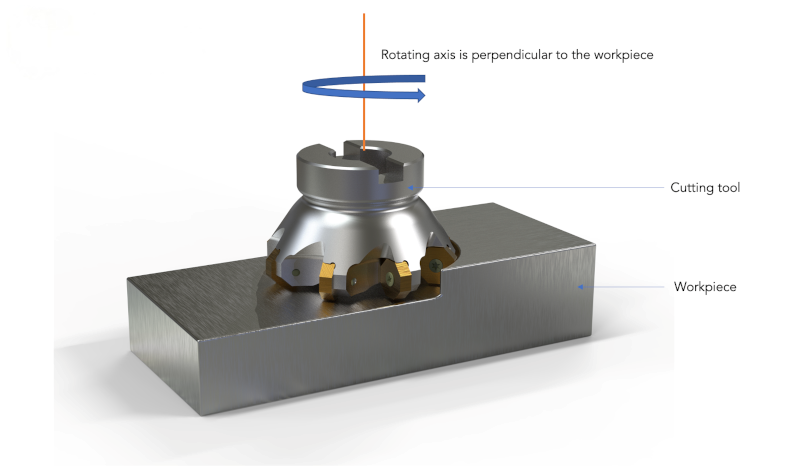
正面フライス加工
Face milling is often considered the “go-to” operation when manufacturers need a flat, smooth surface on their workpiece. この過程で, the cutting tool’s axis of rotation is 垂直 to the surface of the workpiece. This orientation allows the sharp edges on the tool’s face and periphery to remove material efficiently while leaving behind a high-quality surface finish.
What makes face milling so powerful is its high material removal rate. The design of the tool allows it to cut across a broad surface in a single pass, making it excellent for removing excess material quickly. 同時に, it produces a smooth finish, reducing or eliminating the need for secondary finishing operations like grinding or polishing.
Face milling cutters typically come in two types:
Indexable insert cutters – These cutters use replaceable carbide inserts, making them ideal for heavy-duty work.
Solid carbide cutters – These are more expensive but provide excellent precision and durability for fine finishing.
正面フライスの利点:
Fast removal of large amounts of material
Smooth and uniform surface finish
Can be used on both small and large workpieces
アプリケーション:
機械加工 automotive cylinder heads to create perfectly flat sealing surfaces
製造業 ヒートシンク エレクトロニクス用, where smooth surfaces are critical for proper heat transfer
Creating flat bases for molds, 死ぬ, and fixtures in industrial production
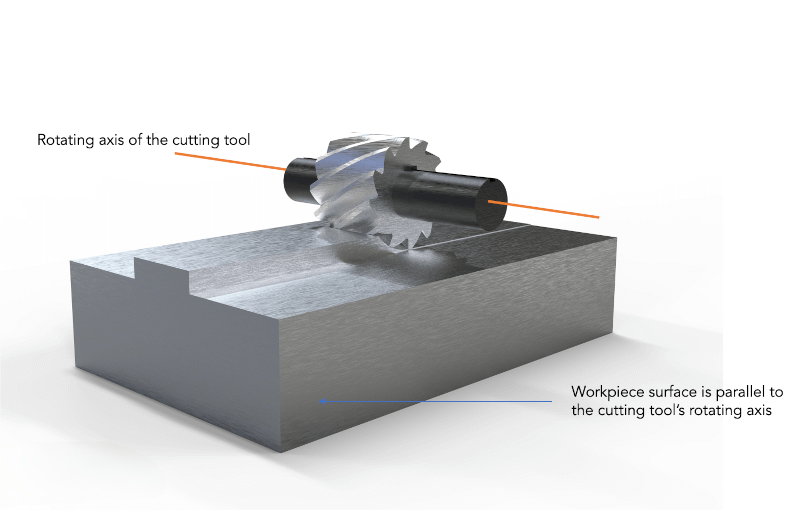
プレーンフライス加工
プレーンフライス加工, sometimes referred to as slab milling, is another widely used operation that produces flat surfaces. しかし, unlike face milling, the cutter in plain milling has its axis of rotation 平行 to the workpiece surface. This orientation allows the cutter to remove material along the length of the workpiece.
The tools used in plain milling are cylindrical cutters with straight or helical teeth. Helical cutters are generally preferred because they provide smoother cutting action and less vibration compared to straight-tooth cutters.
Plain milling is particularly effective for light machining tasks. It doesn’t usually remove large amounts of material quickly, but it ensures uniform removal across the surface, making it ideal for preparing a part for further operations.
プレーンミーリングの利点:
Produces uniform flat surfaces and stepped surfaces
Good for machining contours and shallow slots
Lower cost compared to more complex operations
アプリケーション:
Removing the outer layer of raw material from a workpiece before precision machining
作成 flat bases on large plates and sheets
Producing simple contours and preparing stock for advanced milling
Side Milling
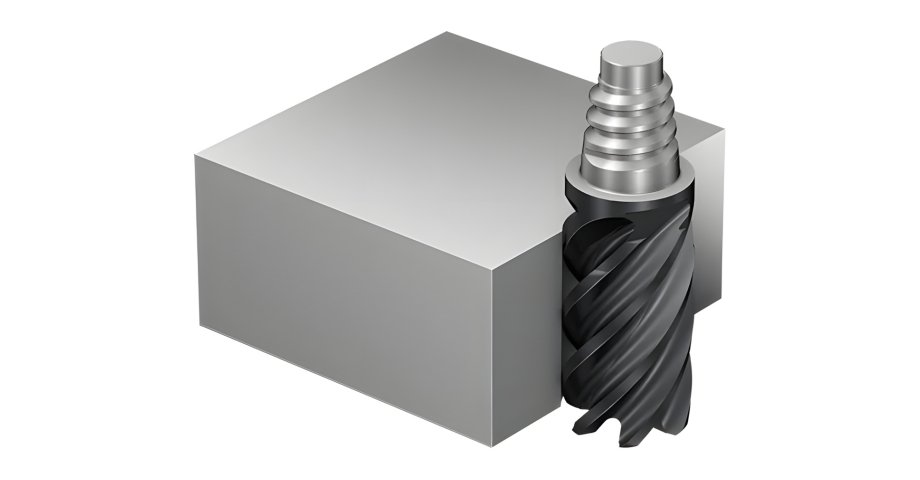
Side Milling
名前が示すように, side milling focuses on machining the sides of a workpiece. It uses cutters with cutting edges on the periphery to create grooves, スロット, or vertical flat surfaces. Side milling can be performed on both vertical and horizontal milling machines, depending on the orientation of the spindle.
The cutters used are typically side-and-face cutters または エンドミル with helical flutes. These cutters are designed to cut with their sides rather than their tips, making them ideal for shaping edges and slots.
What makes side milling versatile is its ability to create complex contours and features like T-slots, fins, とチャンネル. Unlike plain or face milling, which focus mainly on the top surface, side milling lets manufacturers tackle edges and sides, expanding the design possibilities.
Advantages of Side Milling:
Excellent for creating slots and grooves of varying depths
Can produce intricate side features on components
Suitable for machining both soft and hard materials
アプリケーション:
Automotive suspension mounts that require precise slots and edges
Aircraft structural components where weight-reducing grooves are critical
医療用インプラント like joint replacements, which require fine edge details
Heat sinks and cooling fins in electronics
Straddle Milling
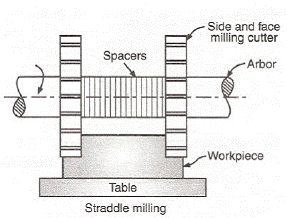
Straddle Milling
Straddle milling is a unique process because it machines two parallel surfaces at the same time. This is achieved by mounting two side cutters on a single arbor, spaced at the required distance apart. As the workpiece moves forward, both cutters remove material simultaneously, leaving behind two identical parallel surfaces.
This operation is particularly valuable for saving time and ensuring symmetry. Instead of milling one side at a time and risking uneven spacing, straddle milling guarantees 均一 1つのセットアップで.
Advantages of Straddle Milling:
Reduces machining time significantly
Ensures precise spacing between two surfaces
Ideal for producing multiple identical profiles in bulk
アプリケーション:
製造業 治具と固定具 used in production lines
作成 括弧, レバー, とギア with parallel slots
機械加工 axle housings and transmission components in the automotive industry
Producing sprockets and mechanical linkages
In industries where precision and speed are equally important, straddle milling proves to be an invaluable operation.
Gang Milling
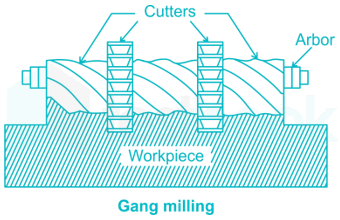
Gang Milling
Gang milling takes the concept of straddle milling even further. Instead of using just two cutters, multiple cutters of different types are mounted on the same arbor. This setup allows several operations to be carried out in a single pass. 例えば, one cutter might create a slot, while another shapes an edge, and yet another flattens the surface—all simultaneously.
This approach greatly reduces machining time and increases efficiency, especially when producing parts with multiple features. しかし, gang milling requires careful setup and precise alignment, as all cutters must engage correctly with the workpiece at the same time.
Advantages of Gang Milling:
Multiple operations completed in a single setup
High efficiency and reduced cycle times
Cost-effective for mass production
アプリケーション:
エンジンブロック そして トランスミッションハウジング in automotive manufacturing
Frames and brackets requiring multiple features
ギアとスプロケット that need various slots and contours
Die prototyping and tool manufacturing where complex features must be created quickly
Gang milling showcases the full power of CNC automation, turning what would normally require multiple operations into a streamlined, single-pass process.
Angle Milling

Angle Milling
Angle milling is the process of cutting a workpiece at a specific angle other than 90°. Unlike face or plain milling, where surfaces are machined flat, angle milling allows the creation of slanted, beveled, or angular features. This is achieved by using either single-angle or double-angle milling cutters.
例えば, ある single-angle cutter might be used to cut a 45° chamfer, その間 double-angle cutter could create a V-shaped groove. Angle milling operations are often performed with the help of fixtures or angle plates that hold the workpiece at the correct orientation.
アングルミリングの利点:
High precision in creating chamfers, ベベル, and angled slots
Ability to produce T-slots and dovetail slides commonly used in machine tool design
Flexibility to cut both fixed angles (like 45° or 60°) and custom angles
アプリケーション:
機械加工 T-slots on machine beds, where fixtures and clamps are mounted
作成 dovetail slides for tools, which allow smooth linear movement
追加 面取りと面取り to components for both functionality and aesthetics
製造業 complex joints used in mechanical systems
Angle milling is widely used in toolmaking, die manufacturing, and industries that require precise angled features.
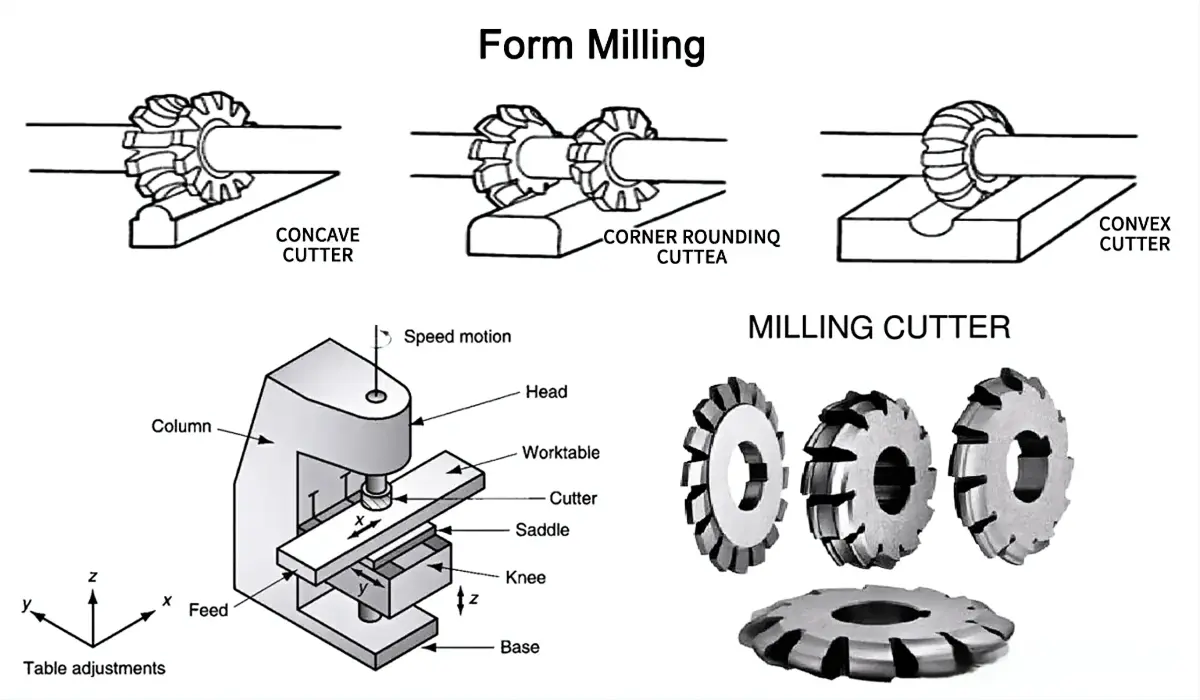
フォームミリング
Form milling is all about shaping irregular contours and complex surfaces. Unlike basic operations that produce flat or simple geometric features, form milling employs cutters shaped as the negative profile of the desired contour. When the cutter rotates across the workpiece, it produces the intended 3D geometry.
This technique is perfect for parts that require unique shapes, 曲線, または複雑な詳細. Since the cutter itself carries the profile, the machine doesn’t need advanced multi-axis movements to achieve complex contours.
Advantages of Form Milling:
Ability to produce highly customized and irregular shapes
Reduced need for multiple operations since one cutter can create a complete profile
Precision shaping of complex surfaces with minimal errors
アプリケーション:
タービンブレード 航空宇宙, which require aerodynamic curved profiles
整形外科インプラント such as knee and hip joints, designed to match human anatomy
Dome-shaped pistons in automotive engines
Custom prototypes and molds for product development
Guitar bodies and artistic components, where aesthetics are as important as function
Form milling highlights the versatility of CNC technology, transforming raw materials into parts with both functional and artistic value.
エンドミル加工
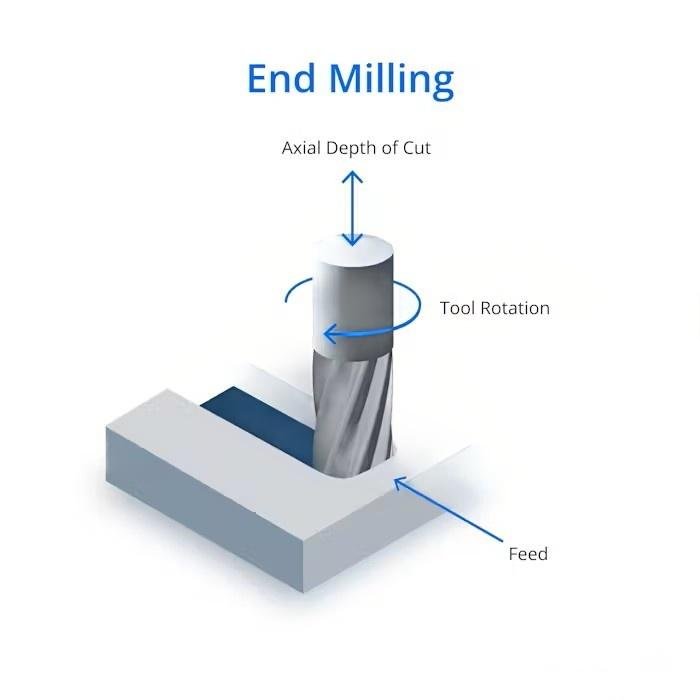
エンドミル加工
End milling is perhaps the most versatile and commonly used CNC milling operation. It employs end mills—cutters with multiple cutting edges on both the tip and sides. This dual-action cutting allows the tool to shape the workpiece in many ways, including creating profiles, スロット, ポケット, and intricate surface details.
End mills come in different varieties, のような:
フラットエンドミルズ – For creating sharp-edged profiles and slots
Ball nose end mills – For curved surfaces and 3D contouring
Corner radius end mills – For producing rounded edges and preventing chipping
What sets end milling apart is its ability to machine with precision and flexibility. Whether you need fine grooves, deep slots, or smooth surface finishes, end milling can handle the task.
エンドミル加工のメリット:
Exceptional flexibility for producing a wide range of geometries
High accuracy for detailed machining
Capable of producing smooth surface finishes and sharp edges
アプリケーション:
精密部品 in electronics and medical devices
ツールとダイ作り, where detailed cavities and slots are needed
自動車部品 like engine housings and mounts
プロトタイピング of complex designs in various materials
Because of its adaptability, end milling is considered the workhorse of CNC operations.
Saw Milling
Saw milling is a specialized operation that uses a large circular cutter with teeth around its circumference to slice through a workpiece. Much like a saw in woodworking, this process is perfect for creating narrow slots, dividing material into sections, or parting off components.
Although slower compared to other milling techniques, saw milling is very effective when precise slots or separations are required. One challenge with saw milling is heat generation—because of the cutter’s size and depth of cut, the process can create friction that leads to thermal stress on both the tool and the workpiece.
Advantages of Saw Milling:
Ideal for cutting deep, narrow slots
Effective for parting off large sections of material
Can produce straight cuts with minimal material waste
アプリケーション:
作成 slots in gears or pulleys
Dividing large workpieces into smaller parts
切断 grooves in mechanical assemblies
Producing profiles or slight curves in specialized components
Despite its limitations in speed, saw milling remains a reliable operation where precision slots and divisions are necessary.
Gear Milling
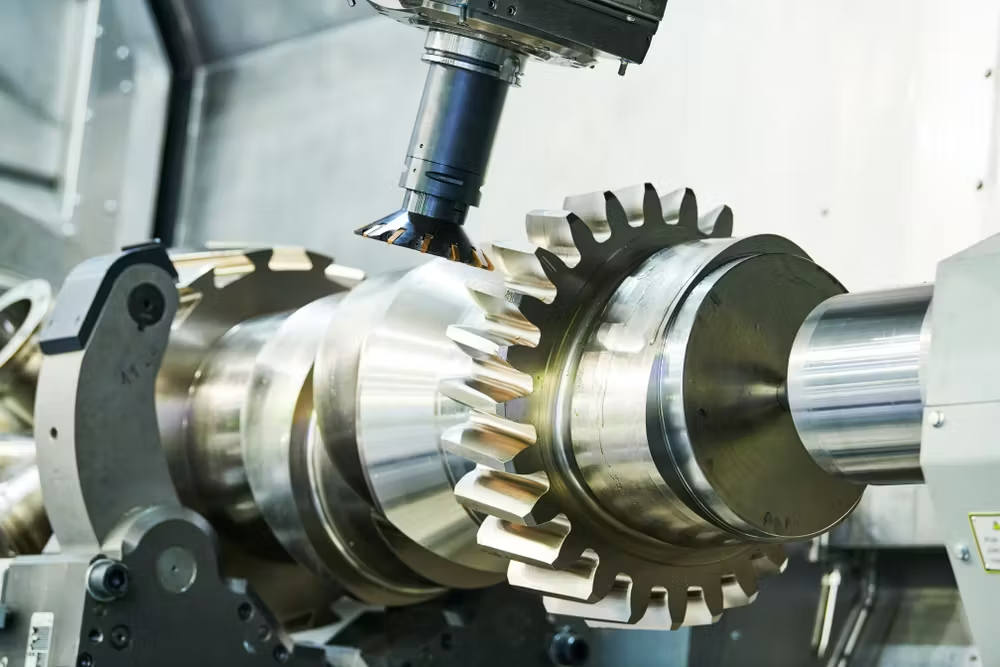
Gear Milling
Gear milling is a specialized operation dedicated to the production of gears. Unlike general milling processes, this operation requires specially designed gear cutters or gear hobbing tools. These cutters shape the teeth of the gear to precise dimensions, ensuring proper meshing with other gears in mechanical systems.
The accuracy required in gear milling is extremely high, as even the slightest deviation can lead to inefficiency, ノイズ, or mechanical failure. CNC gear milling ensures that gears are manufactured with consistent tooth profiles and surface finishes.
Advantages of Gear Milling:
High precision in cutting gear teeth
Ability to create gears of various types: spur, ベベル, helical, or rack-and-pinion
Flexibility to refine pre-formed gears or manufacture new ones from scratch
アプリケーション:
Automotive transmissions, where gears control speed and torque
産業機械, including conveyors and heavy equipment
Aerospace systems, where lightweight yet precise gears are critical
ロボット工学, requiring compact gears with accurate meshing
Gear milling is often considered one of the most costly operations, but its importance cannot be overstated—it literally keeps machines moving smoothly.
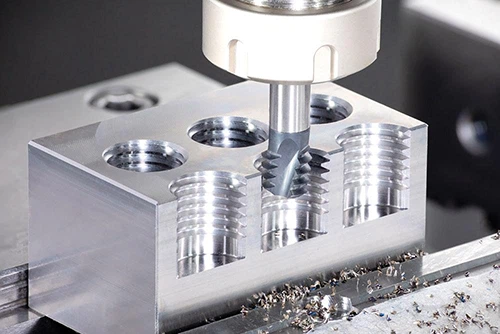
ねじ切り加工
Thread milling is a highly efficient method for cutting both internal and external threads on a workpiece. Unlike tapping, which is limited to cutting internal threads with a fixed-size tool, thread milling uses specialized thread mill cutters that allow greater flexibility.
In thread milling, the tool follows a helical path, gradually carving the thread into the material. This method is especially useful for large-diameter holes, where taps would be impractical or prone to breaking.
Advantages of Thread Milling:
Flexibility to cut different thread sizes with one tool
Produces high-quality threads with better surface finishes than tapping
Lower risk of tool breakage compared to tapping
Ability to cut both left-hand and right-hand threads
アプリケーション:
Automotive engines, where threaded holes are essential for assembly
家電, requiring precision threads for fasteners
産業機械, with large threaded holes for assembly parts
航空宇宙部品, where high-strength threaded joints are critical
Thread milling has become a preferred choice in industries that require precision threading and versatility.
CAM Milling
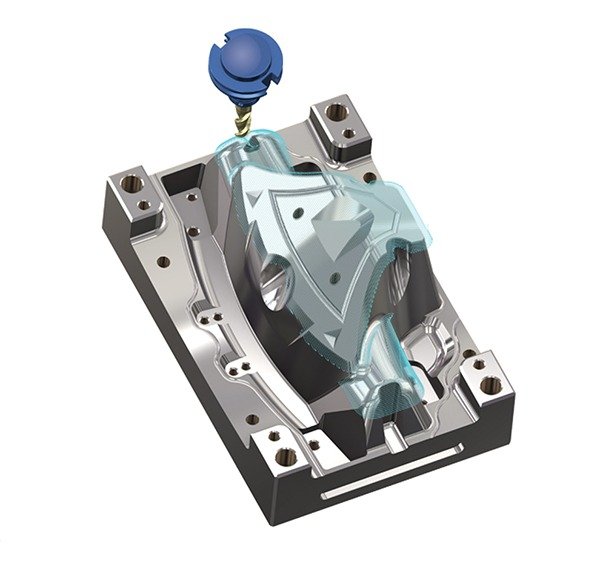
CAM Milling
CAM milling is used to produce カム, which are mechanical components that convert rotational motion into linear motion—or vice versa. These are essential in machinery such as engines, automation systems, and textile machines.
The process involves using a dividing head tool to rotate the workpiece while the cutter removes material according to the cam’s profile. Because cams often have irregular shapes, this operation requires extreme precision to ensure smooth motion in the final application.
Advantages of CAM Milling:
High accuracy in creating cam profiles
Ensures smooth motion transfer in mechanical systems
Customizable for different cam designs and functions
アプリケーション:
Automotive camshafts, which control the opening and closing of engine valves
Textile machinery, requiring cams for repetitive motion cycles
Automation equipment, converting continuous motion into programmed movements
Mechanical clocks and devices, where cams regulate motion cycles
CAM milling is highly specialized but crucial for industries that rely on motion conversion.
Types of CNC Milling Operations Based on Mechanisms
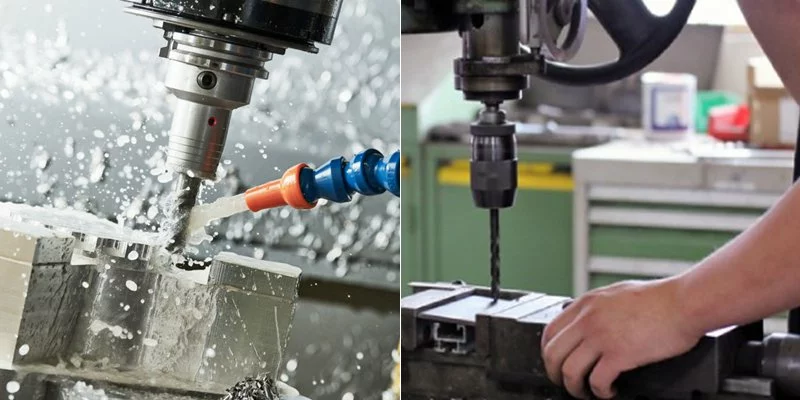
Manual Milling
Beyond the geometry of cuts, milling operations can also be classified by how they are executed. Three major categories stand out:
Manual Milling
手動ミリングで, the operator is responsible for setting up the workpiece, adjusting parameters, and moving the cutter. This gives flexibility for one-off parts or custom work but sacrifices speed and precision.
長所: Low setup cost, フレキシブル, ideal for prototypes
短所: 時間がかかる, less accurate, 労働集約的
CNCフライス加工
CNC milling automates the entire process using computer programs. Multi-axis CNC machines (3–6 axes) can handle complex geometries with unmatched precision.
長所: 高精度, 再現性, efficient for mass production
短所: セットアップコストが高くなります, requires programming expertise
Conventional vs. 登るミリング
These two methods differ in how the cutter rotates relative to the feed direction:
| 特徴 | 従来の製粉 | 登るミリング |
| Tool vs. Feed Direction | Opposite | Same |
| 表面仕上げ | 粗い | よりスムーズ |
| 工具の摩耗 | より高い | より低い |
| 材料の除去 | Lower efficiency | より高い効率 |
| に最適です | より柔らかい素材 | もっと強く, consistent materials |
Choosing the right mechanism depends on both material type and project requirements.
Factors to Consider When Choosing Milling Operations
With so many operations available, how do you decide which one is best for your project? Here are the main factors:
材料の種類
Different materials behave differently under cutting forces. Hard materials like tool steel may require slower feed rates and specific cutters, while softer materials like aluminum allow faster machining.
Desired Surface Finish
Each operation delivers a unique surface roughness. 例えば, face milling provides Ra 0.8–3.2 µm, while slot milling may only achieve Ra 1.6–6.3 µm. Matching your required finish to the right operation prevents extra finishing work.
Geometric Complexity
Simple parts may only need plain or face milling. But for intricate parts, such as gears or threads, specialized operations like gear milling or thread milling are essential.
Machine Parameters and Settings
Spindle speed, cutting depth, and feed rates directly affect both efficiency and finish. Multi-axis capabilities also open the door to more complex geometries.
Selecting the Right Cutter
Cutter choice is just as important as the operation itself. Flat end mills are great for sharp edges, while ball nose cutters excel at curved surfaces. Using the wrong tool can lead to poor results or tool damage.
結論
CNC milling is more than just cutting metal—it’s a precision art combined with advanced engineering. From simple flat surfaces to intricate gears and threads, CNC milling offers operations tailored to every manufacturing challenge.
Each type of milling operation—whether it’s face milling for smooth surfaces, gear milling for precision teeth, or form milling for irregular contours—plays a vital role in modern production. Choosing the right operation, along with the right tool and machine parameters, ensures efficiency, 正確さ, および費用対効果.
As industries demand more complex and high-quality parts, CNC milling will continue to be at the heart of modern manufacturing.
よくある質問
- What are the basic types of milling machines?
The two main types are horizontal milling machines(where the spindle is parallel to the ground) そして vertical milling machines(where the spindle is perpendicular). - Which milling operation provides the highest precision?
フォームミリングis considered one of the most precise, as it uses a specially shaped cutter to directly produce complex contours with minimal errors. - Which milling operation is the most expensive?
Gear millingoften incurs the highest costs due to the need for specialized cutters, longer cycle times, and highly precise setups. - Which operation is the most cost-effective?
プレーンフライス加工(or slab milling) is the most cost-effective. It’s simple, requires fewer tools, and works efficiently on flat surfaces. - What is the main difference between CNC and manual milling?
Manual milling relies on human control and is better for custom, 一回限りの部分. CNC milling is automated, もっと早く, より正確です, and ideal for mass production.


